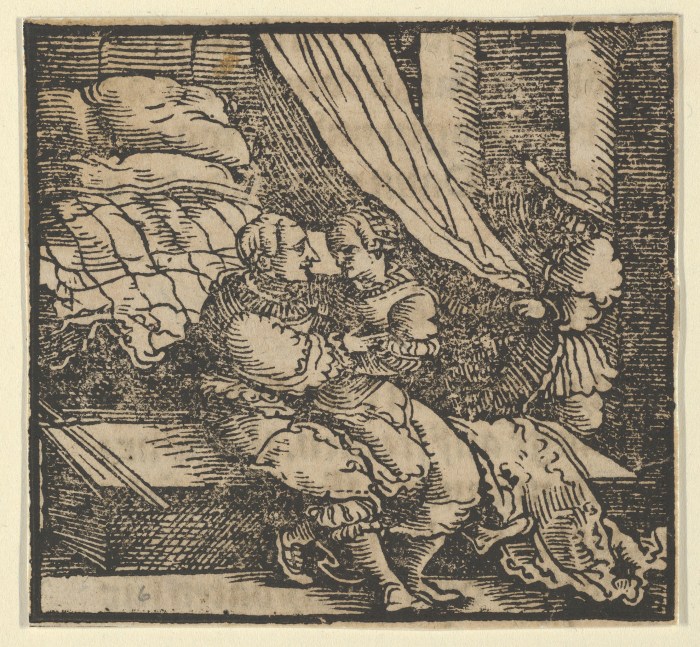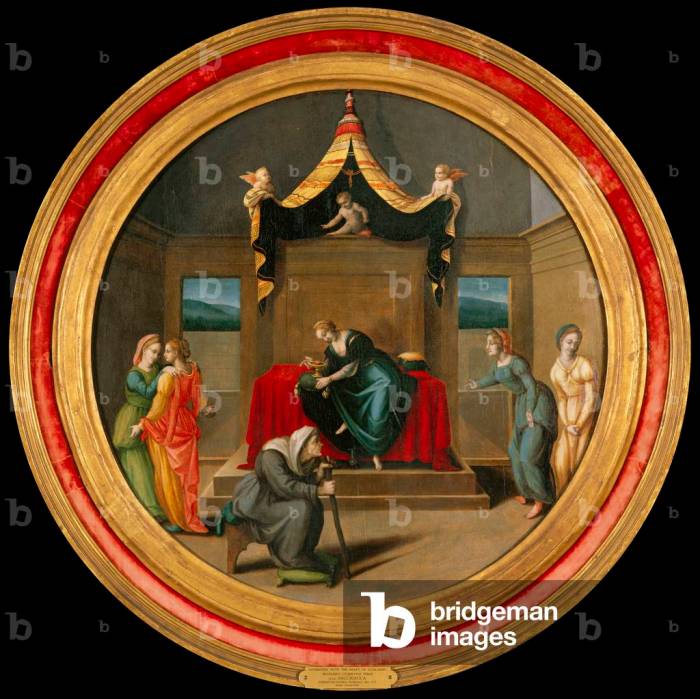Ghismonda with the Heart of Guiscardo is a captivating narrative that explores the timeless themes of love, loyalty, and betrayal. This enthralling story has captivated audiences for centuries, inspiring numerous artistic interpretations and literary adaptations. As we delve into the depths of this tragic tale, we will uncover its historical context, central themes, character development, literary techniques, cultural impact, and artistic depictions.
The story unfolds in medieval Italy, where Ghismonda, a beautiful and virtuous noblewoman, falls deeply in love with Guiscardo, a handsome young squire. Their secret affair is discovered by Ghismonda’s father, Tancred, who is enraged by the perceived betrayal. In a fit of jealous fury, Tancred murders Guiscardo and sends his heart to Ghismonda, who, consumed by grief, takes her own life.
Historical Context
The story of Ghismonda and Guiscardo is set in Salerno, Italy, during the 14th century. The city was a major center of trade and culture, and it was ruled by the Sanseverino family. Tancred, the Prince of Salerno, was a cruel and tyrannical ruler, and his daughter, Ghismonda, was a beautiful and virtuous young woman.
Ghismonda fell in love with Guiscardo, a young squire in her father’s court. Their love was forbidden, but they continued to meet in secret. Tancred eventually discovered their affair, and he had Guiscardo killed. Ghismonda was so grief-stricken that she killed herself.
Significance of the Setting and Characters
The story of Ghismonda and Guiscardo is a tragic tale of love and loss. It is also a reflection of the social and political conditions of the time. The setting of the story is important because it helps to create the atmosphere of the story.
Salerno was a wealthy and prosperous city, but it was also a place of violence and injustice. Tancred was a cruel and tyrannical ruler, and his people lived in fear of him. Ghismonda and Guiscardo were victims of Tancred’s cruelty, and their story is a reminder of the dangers of living under a tyrannical regime.
The characters in the story are also important. Ghismonda is a beautiful and virtuous young woman, and she is a victim of her father’s cruelty. Guiscardo is a brave and loyal young man, and he is willing to die for his love.
Tancred is a cruel and tyrannical ruler, and he is the cause of Ghismonda and Guiscardo’s deaths.
Themes and Symbolism

Boccaccio’s “Ghismonda and the Heart of Guiscardo” delves into profound themes and employs evocative symbolism to convey them.
Love and Loyalty
Love serves as a central theme, portrayed as a powerful and consuming force. Ghismonda’s unwavering love for Guiscardo drives her actions, ultimately leading to her tragic end. Loyalty, too, plays a crucial role, as Ghismonda remains steadfast in her devotion to Guiscardo, despite the dire consequences she faces.
Betrayal
Betrayal emerges as a devastating force in the story. Tancred’s discovery of Ghismonda and Guiscardo’s affair results in a cruel and vengeful act, shattering the bonds of trust and loyalty within the family. Guiscardo’s murder becomes the ultimate symbol of betrayal, leaving Ghismonda shattered and consumed by grief.
Symbolism, Ghismonda with the heart of guiscardo
Boccaccio employs potent symbolism to enhance the narrative’s emotional impact. The heart, a traditional symbol of love and passion, takes on a macabre significance as Guiscardo’s heart is presented to Ghismonda in a golden cup. This grotesque act underscores the brutal and heartless nature of Tancred’s betrayal.
Character Analysis
The novella features a complex cast of characters who drive the plot and embody various themes. Ghismonda, Guiscardo, and Tancred stand out as the central figures whose actions and motivations shape the narrative.
Ghismonda
Ghismonda is the protagonist of the story, a beautiful and intelligent young woman. Her character is marked by her strength, independence, and unwavering love for Guiscardo. Despite her father’s disapproval, Ghismonda defies social norms and pursues her own desires. Throughout the story, she undergoes a significant transformation, evolving from a sheltered and obedient daughter to a courageous and determined woman who is willing to sacrifice everything for love.
Guiscardo
Guiscardo is Ghismonda’s lover, a handsome and brave young squire. His character serves as a foil to Tancred’s harshness and tyranny. Guiscardo represents the power of love and the importance of following one’s heart. He is a loyal and devoted companion to Ghismonda, willing to risk his life for her.
Through his actions, Guiscardo challenges the rigid social hierarchy and the authority of those who seek to control others.
Tancred
Tancred is Ghismonda’s father, a powerful and ruthless prince. His character embodies the harsh realities of feudal society, where power and authority often override compassion and justice. Tancred is driven by pride and a desire to maintain control over his daughter’s life.
His actions towards Ghismonda and Guiscardo reveal the extent of his tyranny and the consequences of defying his will.
Literary Techniques: Ghismonda With The Heart Of Guiscardo
Boccaccio employs various literary devices to enhance the story’s impact and create a captivating narrative.
Foreshadowing
Boccaccio subtly foreshadows events throughout the tale. For instance, Guiscardo’s initial encounter with Ghismonda in the garden hints at their future forbidden love. Similarly, Tancred’s discovery of Guiscardo’s lute in Ghismonda’s chamber foreshadows the tragic revelation of their affair.
Irony
Irony plays a significant role in the story. Tancred’s self-imposed isolation, intended to protect Ghismonda, ironically leads to her downfall. Additionally, the fact that Guiscardo’s heart is sent to Ghismonda in a golden cup, a symbol of love, adds a cruel irony to her demise.
Suspense
Boccaccio builds suspense through the gradual revelation of events. The reader is kept on the edge of their seat as they anticipate the consequences of Guiscardo and Ghismonda’s forbidden love. The moment of Tancred’s discovery is particularly suspenseful, as the reader anxiously awaits the outcome for the star-crossed lovers.
Narrative Structure
The story’s episodic structure contributes to its impact. Each episode builds upon the previous one, creating a sense of progression and anticipation. The final episode, in which Guiscardo’s heart is sent to Ghismonda, serves as a powerful climax and resolution.
Cultural Impact

The story of Ghismonda and the Heart of Guiscardo has had a profound impact on literature, art, and popular culture. Its themes of love, loss, and revenge have resonated with audiences for centuries, and the story has been adapted and reinterpreted in countless ways.
Literature
The story of Ghismonda and Guiscardo has been a popular subject for literary adaptations since the Middle Ages. One of the most famous versions is the 14th-century poem by Giovanni Boccaccio, which was included in his collection Decameron. Boccaccio’s version of the story is notable for its vivid descriptions of the characters and its exploration of the psychological effects of love and loss.Other
notable literary adaptations of the story include:
- The play “Tancred and Sigismunda” by James Thomson (1745)
- The novel “The Heart of Mid-Lothian” by Sir Walter Scott (1818)
- The short story “The Cask of Amontillado” by Edgar Allan Poe (1846)
Art
The story of Ghismonda and Guiscardo has also been a popular subject for artists. One of the most famous depictions of the story is the painting “Ghismonda” by Paolo Veronese (1555). Veronese’s painting shows Ghismonda holding the heart of Guiscardo in her hand, and it is a powerful and moving depiction of the story’s tragic events.Other
notable artistic depictions of the story include:
- The sculpture “Ghismonda and Guiscardo” by Antonio Canova (1797)
- The painting “Ghismonda and Tancred” by Eugène Delacroix (1836)
- The painting “Ghismonda” by Dante Gabriel Rossetti (1860)
Popular Culture
The story of Ghismonda and Guiscardo has also been adapted for popular culture. One of the most famous adaptations is the 1948 film “The Red Shoes,” which is loosely based on the story. The film tells the story of a young ballerina who falls in love with a composer, and the tragic consequences that ensue.Other
notable popular culture adaptations of the story include:
- The opera “Tancredi” by Gioachino Rossini (1813)
- The ballet “Ghismonda” by Marius Petipa (1892)
- The television series “The Borgias” (2011)
The story of Ghismonda and the Heart of Guiscardo continues to be a popular and enduring tale of love, loss, and revenge. Its themes and characters have resonated with audiences for centuries, and it is likely that the story will continue to be adapted and reinterpreted for many years to come.
Artistic Depictions
Ghismonda and Guiscardo’s tragic love story has inspired numerous artistic representations throughout history, including paintings and sculptures that vividly capture the emotions and drama of the narrative.
Paintings
Notable paintings depicting scenes from the story include:
- “Ghismonda and Guiscardo” by Giovanni Boccaccio (c. 1370):This iconic painting depicts Ghismonda discovering Guiscardo’s severed head, with a poignantly expressive depiction of her grief and despair.
- “Ghismonda and Guiscardo” by Piero di Cosimo (c. 1500):This allegorical painting shows Ghismonda as a symbol of virtue and chastity, with Guiscardo representing temptation and passion.
Sculpture
Sculptures representing Ghismonda and Guiscardo convey the emotional and symbolic significance of their story:
- “Ghismonda and Guiscardo” by Antonio Canova (c. 1805):This life-sized marble sculpture depicts Ghismonda mourning over Guiscardo’s heart, capturing the depth of her love and anguish.
- “Ghismonda” by Lorenzo Bartolini (c. 1820):This bronze statue portrays Ghismonda as a solitary figure, symbolizing her isolation and the tragedy of her forbidden love.
Comparison to Other Works
The story of Ghismonda and Guiscardo has been compared to other literary works that explore similar themes of love, honor, and sacrifice. These works include:
- Romeo and Julietby William Shakespeare: This play tells the story of two young lovers who are forbidden from being together due to their families’ feud. Like Ghismonda and Guiscardo, Romeo and Juliet are willing to risk their lives for their love.
- Tristan and Isolde: This medieval romance tells the story of two lovers who are separated by fate. Like Ghismonda and Guiscardo, Tristan and Isolde are willing to die for their love.
- The Decameronby Giovanni Boccaccio: This collection of stories includes a tale about a young woman who falls in love with a man who is below her social status. Like Ghismonda and Guiscardo, the woman in this story is willing to defy her family and society to be with her lover.
The story of Ghismonda and Guiscardo is unique in that it explores the theme of female agency. Ghismonda is a strong and independent woman who is willing to fight for her love. She is not afraid to defy her father and society to be with Guiscardo.
This makes her a unique and inspiring character in literature.
FAQs
Who is Ghismonda?
Ghismonda is a beautiful and virtuous noblewoman who falls deeply in love with Guiscardo, a handsome young squire.
Who is Guiscardo?
Guiscardo is a handsome young squire who falls in love with Ghismonda. He is murdered by Ghismonda’s father, Tancred, who is enraged by their secret affair.
Why does Tancred kill Guiscardo?
Tancred kills Guiscardo because he is enraged by their secret affair. He sees Guiscardo as a threat to his honor and family.
How does Ghismonda react to Guiscardo’s death?
Ghismonda is consumed by grief after Guiscardo’s death. She takes her own life by drinking poison.
